Measurement and Decision Making: A Review of the Article on Nursing and Midwifery Practice
VerifiedAdded on 2023/06/10
|16
|4679
|365
AI Summary
This paper presents a review of the article on decision making in nursing and midwifery practice. It discusses different models and frameworks, positive and negative points of the article, and presents a brief analysis of the methods and models used.
Contribute Materials
Your contribution can guide someone’s learning journey. Share your
documents today.
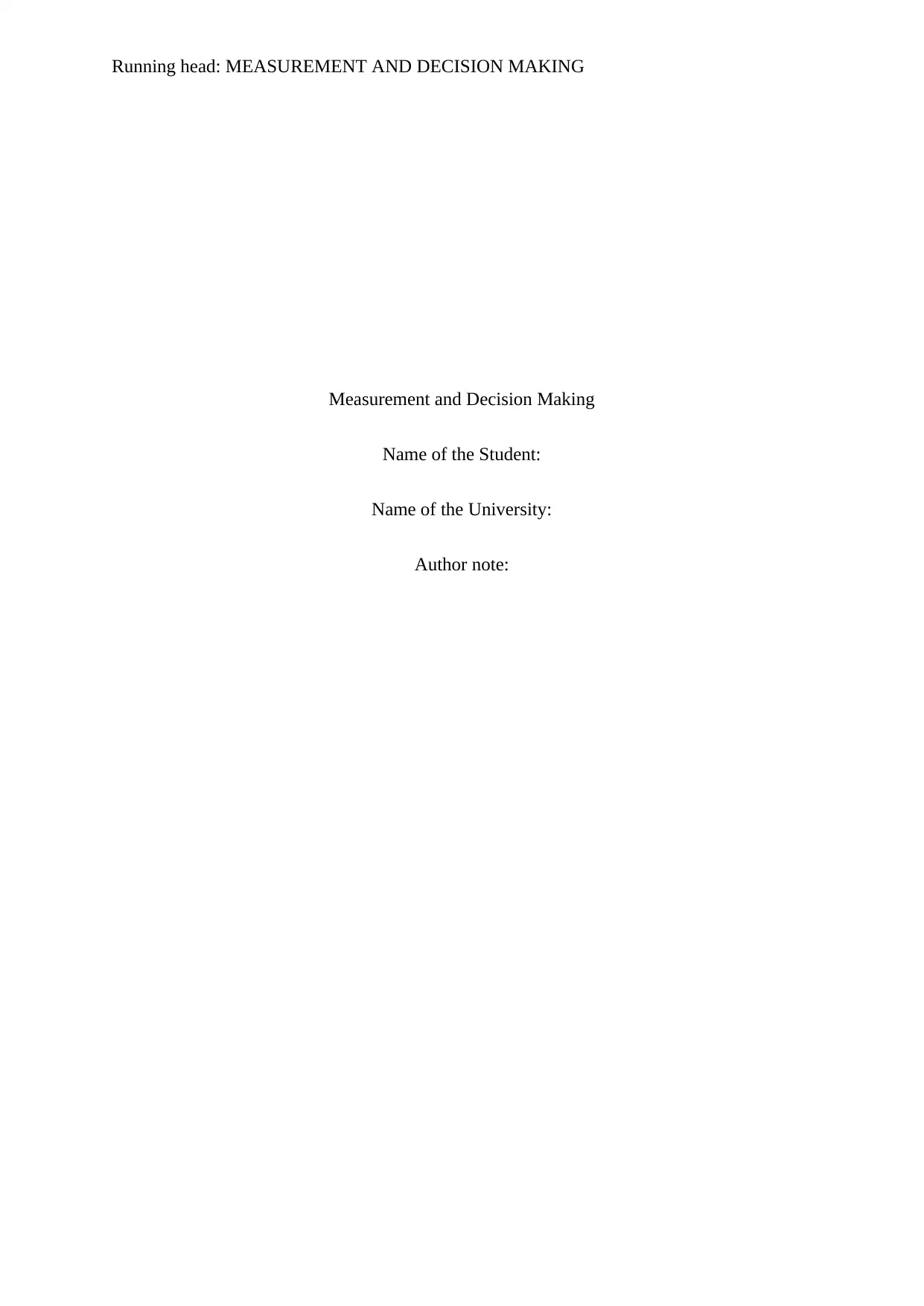
Running head: MEASUREMENT AND DECISION MAKING
Measurement and Decision Making
Name of the Student:
Name of the University:
Author note:
Measurement and Decision Making
Name of the Student:
Name of the University:
Author note:
Secure Best Marks with AI Grader
Need help grading? Try our AI Grader for instant feedback on your assignments.
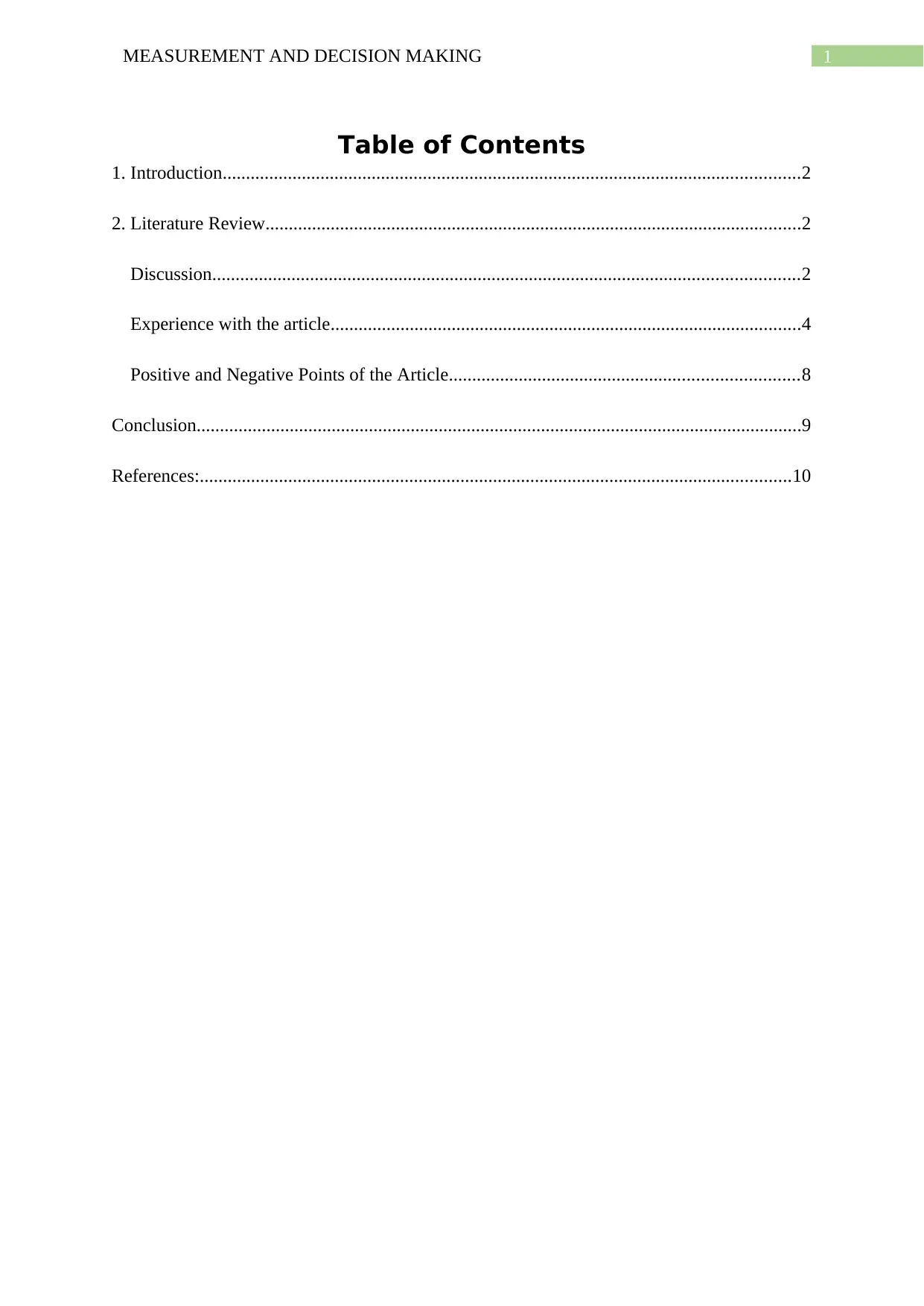
1MEASUREMENT AND DECISION MAKING
Table of Contents
1. Introduction............................................................................................................................2
2. Literature Review...................................................................................................................2
Discussion..............................................................................................................................2
Experience with the article.....................................................................................................4
Positive and Negative Points of the Article...........................................................................8
Conclusion..................................................................................................................................9
References:...............................................................................................................................10
Table of Contents
1. Introduction............................................................................................................................2
2. Literature Review...................................................................................................................2
Discussion..............................................................................................................................2
Experience with the article.....................................................................................................4
Positive and Negative Points of the Article...........................................................................8
Conclusion..................................................................................................................................9
References:...............................................................................................................................10
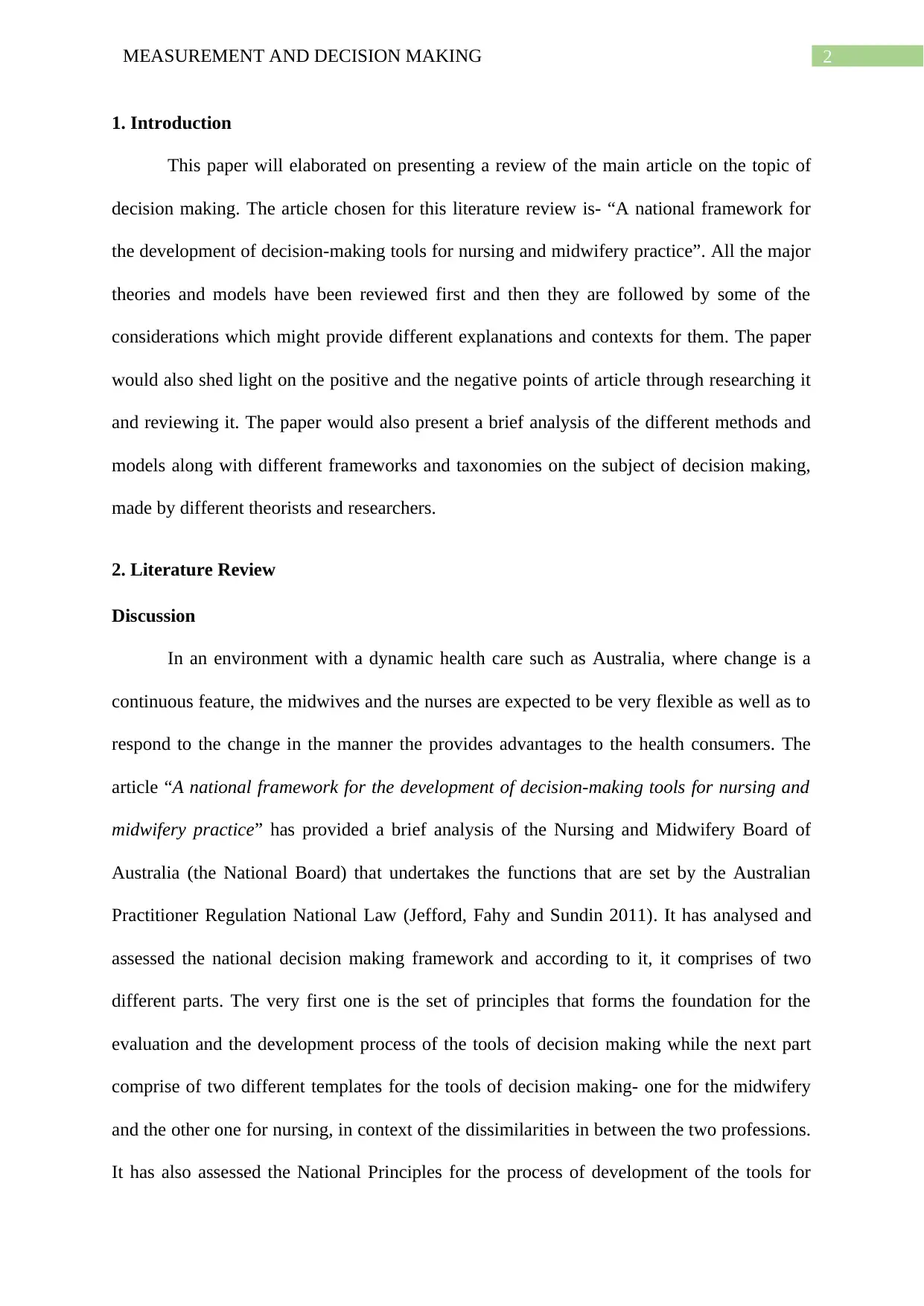
2MEASUREMENT AND DECISION MAKING
1. Introduction
This paper will elaborated on presenting a review of the main article on the topic of
decision making. The article chosen for this literature review is- “A national framework for
the development of decision-making tools for nursing and midwifery practice”. All the major
theories and models have been reviewed first and then they are followed by some of the
considerations which might provide different explanations and contexts for them. The paper
would also shed light on the positive and the negative points of article through researching it
and reviewing it. The paper would also present a brief analysis of the different methods and
models along with different frameworks and taxonomies on the subject of decision making,
made by different theorists and researchers.
2. Literature Review
Discussion
In an environment with a dynamic health care such as Australia, where change is a
continuous feature, the midwives and the nurses are expected to be very flexible as well as to
respond to the change in the manner the provides advantages to the health consumers. The
article “A national framework for the development of decision-making tools for nursing and
midwifery practice” has provided a brief analysis of the Nursing and Midwifery Board of
Australia (the National Board) that undertakes the functions that are set by the Australian
Practitioner Regulation National Law (Jefford, Fahy and Sundin 2011). It has analysed and
assessed the national decision making framework and according to it, it comprises of two
different parts. The very first one is the set of principles that forms the foundation for the
evaluation and the development process of the tools of decision making while the next part
comprise of two different templates for the tools of decision making- one for the midwifery
and the other one for nursing, in context of the dissimilarities in between the two professions.
It has also assessed the National Principles for the process of development of the tools for
1. Introduction
This paper will elaborated on presenting a review of the main article on the topic of
decision making. The article chosen for this literature review is- “A national framework for
the development of decision-making tools for nursing and midwifery practice”. All the major
theories and models have been reviewed first and then they are followed by some of the
considerations which might provide different explanations and contexts for them. The paper
would also shed light on the positive and the negative points of article through researching it
and reviewing it. The paper would also present a brief analysis of the different methods and
models along with different frameworks and taxonomies on the subject of decision making,
made by different theorists and researchers.
2. Literature Review
Discussion
In an environment with a dynamic health care such as Australia, where change is a
continuous feature, the midwives and the nurses are expected to be very flexible as well as to
respond to the change in the manner the provides advantages to the health consumers. The
article “A national framework for the development of decision-making tools for nursing and
midwifery practice” has provided a brief analysis of the Nursing and Midwifery Board of
Australia (the National Board) that undertakes the functions that are set by the Australian
Practitioner Regulation National Law (Jefford, Fahy and Sundin 2011). It has analysed and
assessed the national decision making framework and according to it, it comprises of two
different parts. The very first one is the set of principles that forms the foundation for the
evaluation and the development process of the tools of decision making while the next part
comprise of two different templates for the tools of decision making- one for the midwifery
and the other one for nursing, in context of the dissimilarities in between the two professions.
It has also assessed the National Principles for the process of development of the tools for

3MEASUREMENT AND DECISION MAKING
decision making. The As per Karmiloff-Smith (2018), reality is very complex but the human
cognition is very restricted and limited. With the same, the decision makers do not have that
amount of exhaustive knowledge of all the different possible alternative and also, they would
not have all the required skills and knowledge in order to sufficiently rank all the alternatives
as well as to calculate their costs along with benefits- rationality is bounded. Based on this,
the decision makers do not attempt for finding the optimum solutions the problem. He has
also stated that many a times the aim of an organisation could not be linked directly to the
operations of its. It would lead to the process of identification of one subordinate goal or say,
“subgoal identification”. With the same, it is also to note that the subgoals are not always
unique and their definition are subjected to decision makers, their knowledge, experience as
well as the environment in which they involve (Jones et al. 2015). With the increase in
complexity, the process of decision making gets divided among many of the specialists and
their works are coordinated through the authority relations and communication.
The article has also shed light on the template tools for the decision making process in
the midwifery and nursing practise. Kennedy et al. (2015) in this context have stated that the
template tools are significant based and they are also sustainable over the period of time. The
decisions that are made by making use of these templates are always grounded in the
informed professional discretion and are guided by the principles. According to the article,
the differences in terms of competence of a person, his education as well as experience are
regarded in using these template tools. It is been said that the midwives and the nurses who
are registered have a significant role to play in the process of coordination and the
supervision of the others who might assist them in the provision of care to the consumers.
Palermo, Power and Ashby (2017) have argued that the means and the ends are interlinked.
The process of decision making is not to be called as discrete event, instead it gradually
becomes a step by step process that considers incremental changes right from status quo
decision making. The As per Karmiloff-Smith (2018), reality is very complex but the human
cognition is very restricted and limited. With the same, the decision makers do not have that
amount of exhaustive knowledge of all the different possible alternative and also, they would
not have all the required skills and knowledge in order to sufficiently rank all the alternatives
as well as to calculate their costs along with benefits- rationality is bounded. Based on this,
the decision makers do not attempt for finding the optimum solutions the problem. He has
also stated that many a times the aim of an organisation could not be linked directly to the
operations of its. It would lead to the process of identification of one subordinate goal or say,
“subgoal identification”. With the same, it is also to note that the subgoals are not always
unique and their definition are subjected to decision makers, their knowledge, experience as
well as the environment in which they involve (Jones et al. 2015). With the increase in
complexity, the process of decision making gets divided among many of the specialists and
their works are coordinated through the authority relations and communication.
The article has also shed light on the template tools for the decision making process in
the midwifery and nursing practise. Kennedy et al. (2015) in this context have stated that the
template tools are significant based and they are also sustainable over the period of time. The
decisions that are made by making use of these templates are always grounded in the
informed professional discretion and are guided by the principles. According to the article,
the differences in terms of competence of a person, his education as well as experience are
regarded in using these template tools. It is been said that the midwives and the nurses who
are registered have a significant role to play in the process of coordination and the
supervision of the others who might assist them in the provision of care to the consumers.
Palermo, Power and Ashby (2017) have argued that the means and the ends are interlinked.
The process of decision making is not to be called as discrete event, instead it gradually
becomes a step by step process that considers incremental changes right from status quo
Secure Best Marks with AI Grader
Need help grading? Try our AI Grader for instant feedback on your assignments.

4MEASUREMENT AND DECISION MAKING
towards the problem solving instead of decision making towards the attainment of any
particular goal. Trianni, Cagno and Farne (2016) further have argued that for him, the process
of decision making is one of the evolutionary processes, instead of a revolutionary one. It is
also to note that this view of Incrementalist is akin to the concept of “learning by doing”. The
incrementalist view puts much effort on the process of implementation of decision instead of
the analytical steps which precedes the decision but also focus on the continuous learning
process from the implemented decision and the multiple feedback loops as well as the
decision adjustments in order to reach to the planned goal (Cascetta et al. 2015). As per
Heyler et al. (2016), the decision are regarded as the outcomes of the standard of organisation
that are the operating procedures instead of a stand-alone and specific decision making
process. Garg (2017) too in this context have argued about the advantages or the benefits of
the organisational experiences that are codified so that the decision making input could move
all through the standard operating processes and result to a decision. The codified
organisational experience would make sure that each and everyone understands the rational
and the outputs of the process of decision making. However, notwithstanding the fact, Block
et al. (2016) have considered this view as “avoidance mode”. They have regarded that any
systematic process of decision making like the standard operating procedures could take
away the thinking piece of the decision making. They were afraid that in such type of
environment, the decision making is made at the cost of innovation.
Experience with the article
The article has presented the research on the individual difference perspective. This
perspective lays emphasis on the individual decision making process, instead of on the group
or organisational process of decision making. Royo-Vela and Hunermund (2016) in this
context have presented their views stating that the managers make use of different processes
and methods so as to come to different conclusions, not depending on the rational choice but
towards the problem solving instead of decision making towards the attainment of any
particular goal. Trianni, Cagno and Farne (2016) further have argued that for him, the process
of decision making is one of the evolutionary processes, instead of a revolutionary one. It is
also to note that this view of Incrementalist is akin to the concept of “learning by doing”. The
incrementalist view puts much effort on the process of implementation of decision instead of
the analytical steps which precedes the decision but also focus on the continuous learning
process from the implemented decision and the multiple feedback loops as well as the
decision adjustments in order to reach to the planned goal (Cascetta et al. 2015). As per
Heyler et al. (2016), the decision are regarded as the outcomes of the standard of organisation
that are the operating procedures instead of a stand-alone and specific decision making
process. Garg (2017) too in this context have argued about the advantages or the benefits of
the organisational experiences that are codified so that the decision making input could move
all through the standard operating processes and result to a decision. The codified
organisational experience would make sure that each and everyone understands the rational
and the outputs of the process of decision making. However, notwithstanding the fact, Block
et al. (2016) have considered this view as “avoidance mode”. They have regarded that any
systematic process of decision making like the standard operating procedures could take
away the thinking piece of the decision making. They were afraid that in such type of
environment, the decision making is made at the cost of innovation.
Experience with the article
The article has presented the research on the individual difference perspective. This
perspective lays emphasis on the individual decision making process, instead of on the group
or organisational process of decision making. Royo-Vela and Hunermund (2016) in this
context have presented their views stating that the managers make use of different processes
and methods so as to come to different conclusions, not depending on the rational choice but
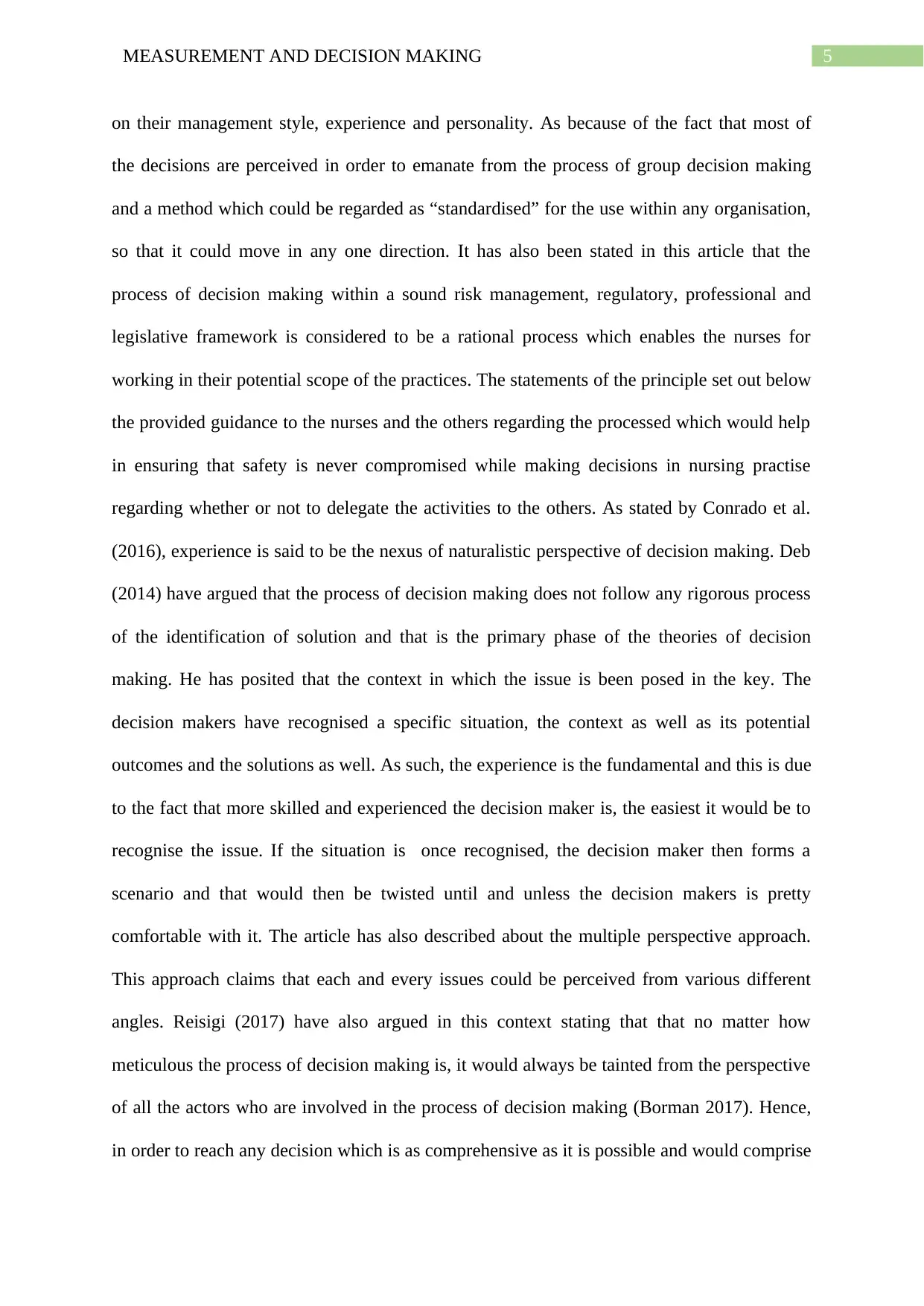
5MEASUREMENT AND DECISION MAKING
on their management style, experience and personality. As because of the fact that most of
the decisions are perceived in order to emanate from the process of group decision making
and a method which could be regarded as “standardised” for the use within any organisation,
so that it could move in any one direction. It has also been stated in this article that the
process of decision making within a sound risk management, regulatory, professional and
legislative framework is considered to be a rational process which enables the nurses for
working in their potential scope of the practices. The statements of the principle set out below
the provided guidance to the nurses and the others regarding the processed which would help
in ensuring that safety is never compromised while making decisions in nursing practise
regarding whether or not to delegate the activities to the others. As stated by Conrado et al.
(2016), experience is said to be the nexus of naturalistic perspective of decision making. Deb
(2014) have argued that the process of decision making does not follow any rigorous process
of the identification of solution and that is the primary phase of the theories of decision
making. He has posited that the context in which the issue is been posed in the key. The
decision makers have recognised a specific situation, the context as well as its potential
outcomes and the solutions as well. As such, the experience is the fundamental and this is due
to the fact that more skilled and experienced the decision maker is, the easiest it would be to
recognise the issue. If the situation is once recognised, the decision maker then forms a
scenario and that would then be twisted until and unless the decision makers is pretty
comfortable with it. The article has also described about the multiple perspective approach.
This approach claims that each and every issues could be perceived from various different
angles. Reisigi (2017) have also argued in this context stating that that no matter how
meticulous the process of decision making is, it would always be tainted from the perspective
of all the actors who are involved in the process of decision making (Borman 2017). Hence,
in order to reach any decision which is as comprehensive as it is possible and would comprise
on their management style, experience and personality. As because of the fact that most of
the decisions are perceived in order to emanate from the process of group decision making
and a method which could be regarded as “standardised” for the use within any organisation,
so that it could move in any one direction. It has also been stated in this article that the
process of decision making within a sound risk management, regulatory, professional and
legislative framework is considered to be a rational process which enables the nurses for
working in their potential scope of the practices. The statements of the principle set out below
the provided guidance to the nurses and the others regarding the processed which would help
in ensuring that safety is never compromised while making decisions in nursing practise
regarding whether or not to delegate the activities to the others. As stated by Conrado et al.
(2016), experience is said to be the nexus of naturalistic perspective of decision making. Deb
(2014) have argued that the process of decision making does not follow any rigorous process
of the identification of solution and that is the primary phase of the theories of decision
making. He has posited that the context in which the issue is been posed in the key. The
decision makers have recognised a specific situation, the context as well as its potential
outcomes and the solutions as well. As such, the experience is the fundamental and this is due
to the fact that more skilled and experienced the decision maker is, the easiest it would be to
recognise the issue. If the situation is once recognised, the decision maker then forms a
scenario and that would then be twisted until and unless the decision makers is pretty
comfortable with it. The article has also described about the multiple perspective approach.
This approach claims that each and every issues could be perceived from various different
angles. Reisigi (2017) have also argued in this context stating that that no matter how
meticulous the process of decision making is, it would always be tainted from the perspective
of all the actors who are involved in the process of decision making (Borman 2017). Hence,
in order to reach any decision which is as comprehensive as it is possible and would comprise

6MEASUREMENT AND DECISION MAKING
of the technical, organisation, as well as the individual views, many of the stakeholders must
be consulted in that case. De Hollander et al. (2016) have claimed that the former theories of
decision making have recommended that while undergoing uncertainty, the decision makes
must search for the additional accurate and relevant information. This in turn would help
them in delaying the process of decision making and with the same, to alter or to change the
performance results and actions. Marraccini et al. (2016) have also showed that the speeder
the process of decision making is, the better it is as the resultant. Their work have depicted
that the most of the successful companies tend to analyse more relevant data and they
consider many alternative side by side and hence, make the process of decision making faster.
To support this evident, Uzelac et al. (2016) too have concluded that the faster process of
decision making has a very productive and positive impact on the growth and profitability.
As per Couet et al. (2015), there are many approaches for understanding or presenting
the process of decision making. According to the process oriented view or perspective, the
process of decision making must be regarded as a process. Graham, Harvey and Puri (2015)
in this context have stated that it is a process of selecting an alternative way from a collection
of alternatives so as to attain the defined goals and objectives. As stated by most of the
authors, the most used model of decision making is BOGSAT. BOGSAT is the acronym for
the “Bunch Of Old Guys Sitting And Talking” (Jett 2014). This term might be a little rude
but it is also to note that it holds a little truth in it. In many of the cases, the models of
decision making and the various different processes are not thought enough in the
organisations where there are fewer resources in order to allocate into the processes other
than the main business functions. However, even though some of the tools that are supporting
the decision making could have been used and the “old guys” might have both the vision and
experience, the cognitive limitations could act as a barrier to the outcome. Hence, the process
of the technical, organisation, as well as the individual views, many of the stakeholders must
be consulted in that case. De Hollander et al. (2016) have claimed that the former theories of
decision making have recommended that while undergoing uncertainty, the decision makes
must search for the additional accurate and relevant information. This in turn would help
them in delaying the process of decision making and with the same, to alter or to change the
performance results and actions. Marraccini et al. (2016) have also showed that the speeder
the process of decision making is, the better it is as the resultant. Their work have depicted
that the most of the successful companies tend to analyse more relevant data and they
consider many alternative side by side and hence, make the process of decision making faster.
To support this evident, Uzelac et al. (2016) too have concluded that the faster process of
decision making has a very productive and positive impact on the growth and profitability.
As per Couet et al. (2015), there are many approaches for understanding or presenting
the process of decision making. According to the process oriented view or perspective, the
process of decision making must be regarded as a process. Graham, Harvey and Puri (2015)
in this context have stated that it is a process of selecting an alternative way from a collection
of alternatives so as to attain the defined goals and objectives. As stated by most of the
authors, the most used model of decision making is BOGSAT. BOGSAT is the acronym for
the “Bunch Of Old Guys Sitting And Talking” (Jett 2014). This term might be a little rude
but it is also to note that it holds a little truth in it. In many of the cases, the models of
decision making and the various different processes are not thought enough in the
organisations where there are fewer resources in order to allocate into the processes other
than the main business functions. However, even though some of the tools that are supporting
the decision making could have been used and the “old guys” might have both the vision and
experience, the cognitive limitations could act as a barrier to the outcome. Hence, the process
Paraphrase This Document
Need a fresh take? Get an instant paraphrase of this document with our AI Paraphraser
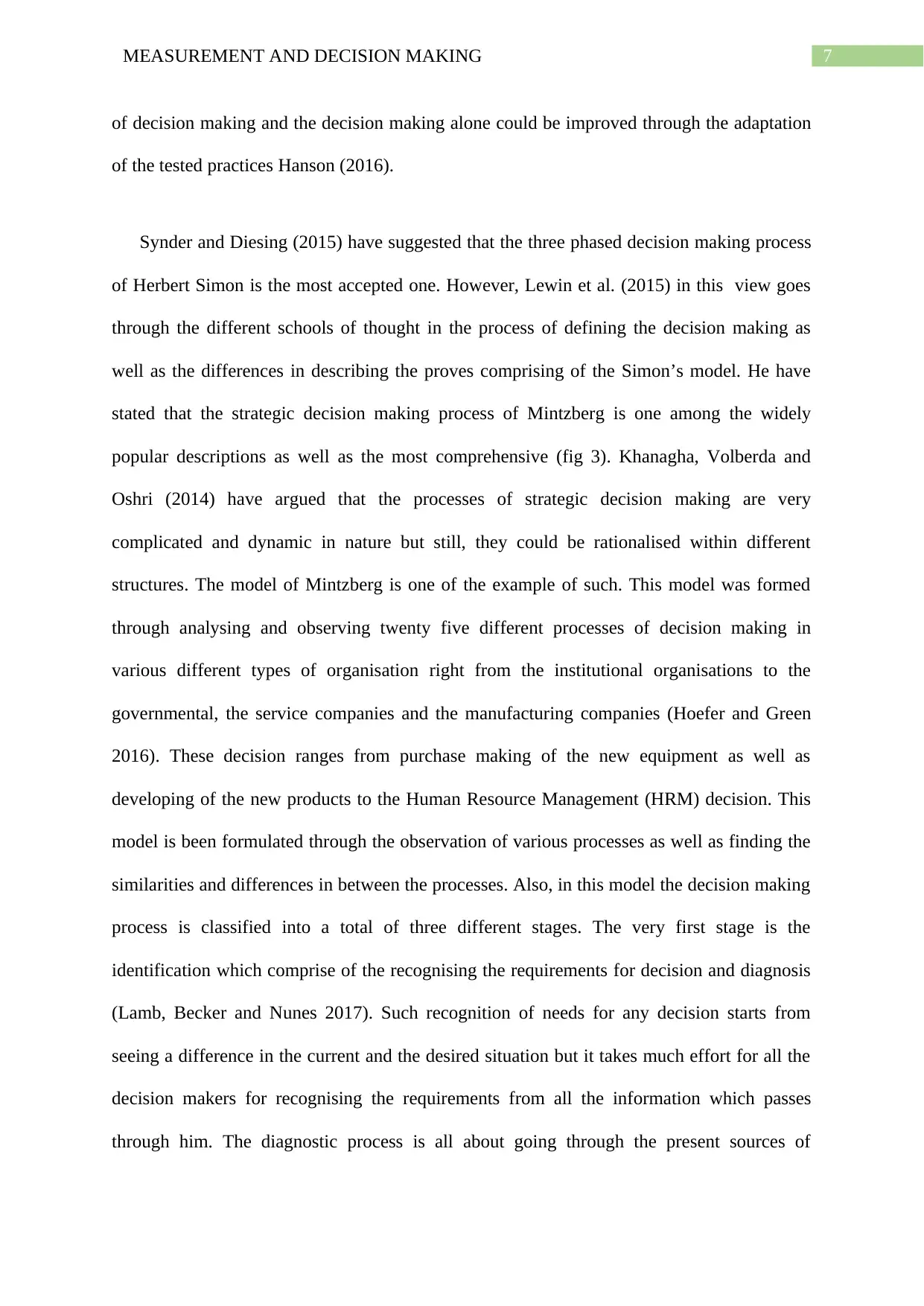
7MEASUREMENT AND DECISION MAKING
of decision making and the decision making alone could be improved through the adaptation
of the tested practices Hanson (2016).
Synder and Diesing (2015) have suggested that the three phased decision making process
of Herbert Simon is the most accepted one. However, Lewin et al. (2015) in this view goes
through the different schools of thought in the process of defining the decision making as
well as the differences in describing the proves comprising of the Simon’s model. He have
stated that the strategic decision making process of Mintzberg is one among the widely
popular descriptions as well as the most comprehensive (fig 3). Khanagha, Volberda and
Oshri (2014) have argued that the processes of strategic decision making are very
complicated and dynamic in nature but still, they could be rationalised within different
structures. The model of Mintzberg is one of the example of such. This model was formed
through analysing and observing twenty five different processes of decision making in
various different types of organisation right from the institutional organisations to the
governmental, the service companies and the manufacturing companies (Hoefer and Green
2016). These decision ranges from purchase making of the new equipment as well as
developing of the new products to the Human Resource Management (HRM) decision. This
model is been formulated through the observation of various processes as well as finding the
similarities and differences in between the processes. Also, in this model the decision making
process is classified into a total of three different stages. The very first stage is the
identification which comprise of the recognising the requirements for decision and diagnosis
(Lamb, Becker and Nunes 2017). Such recognition of needs for any decision starts from
seeing a difference in the current and the desired situation but it takes much effort for all the
decision makers for recognising the requirements from all the information which passes
through him. The diagnostic process is all about going through the present sources of
of decision making and the decision making alone could be improved through the adaptation
of the tested practices Hanson (2016).
Synder and Diesing (2015) have suggested that the three phased decision making process
of Herbert Simon is the most accepted one. However, Lewin et al. (2015) in this view goes
through the different schools of thought in the process of defining the decision making as
well as the differences in describing the proves comprising of the Simon’s model. He have
stated that the strategic decision making process of Mintzberg is one among the widely
popular descriptions as well as the most comprehensive (fig 3). Khanagha, Volberda and
Oshri (2014) have argued that the processes of strategic decision making are very
complicated and dynamic in nature but still, they could be rationalised within different
structures. The model of Mintzberg is one of the example of such. This model was formed
through analysing and observing twenty five different processes of decision making in
various different types of organisation right from the institutional organisations to the
governmental, the service companies and the manufacturing companies (Hoefer and Green
2016). These decision ranges from purchase making of the new equipment as well as
developing of the new products to the Human Resource Management (HRM) decision. This
model is been formulated through the observation of various processes as well as finding the
similarities and differences in between the processes. Also, in this model the decision making
process is classified into a total of three different stages. The very first stage is the
identification which comprise of the recognising the requirements for decision and diagnosis
(Lamb, Becker and Nunes 2017). Such recognition of needs for any decision starts from
seeing a difference in the current and the desired situation but it takes much effort for all the
decision makers for recognising the requirements from all the information which passes
through him. The diagnostic process is all about going through the present sources of
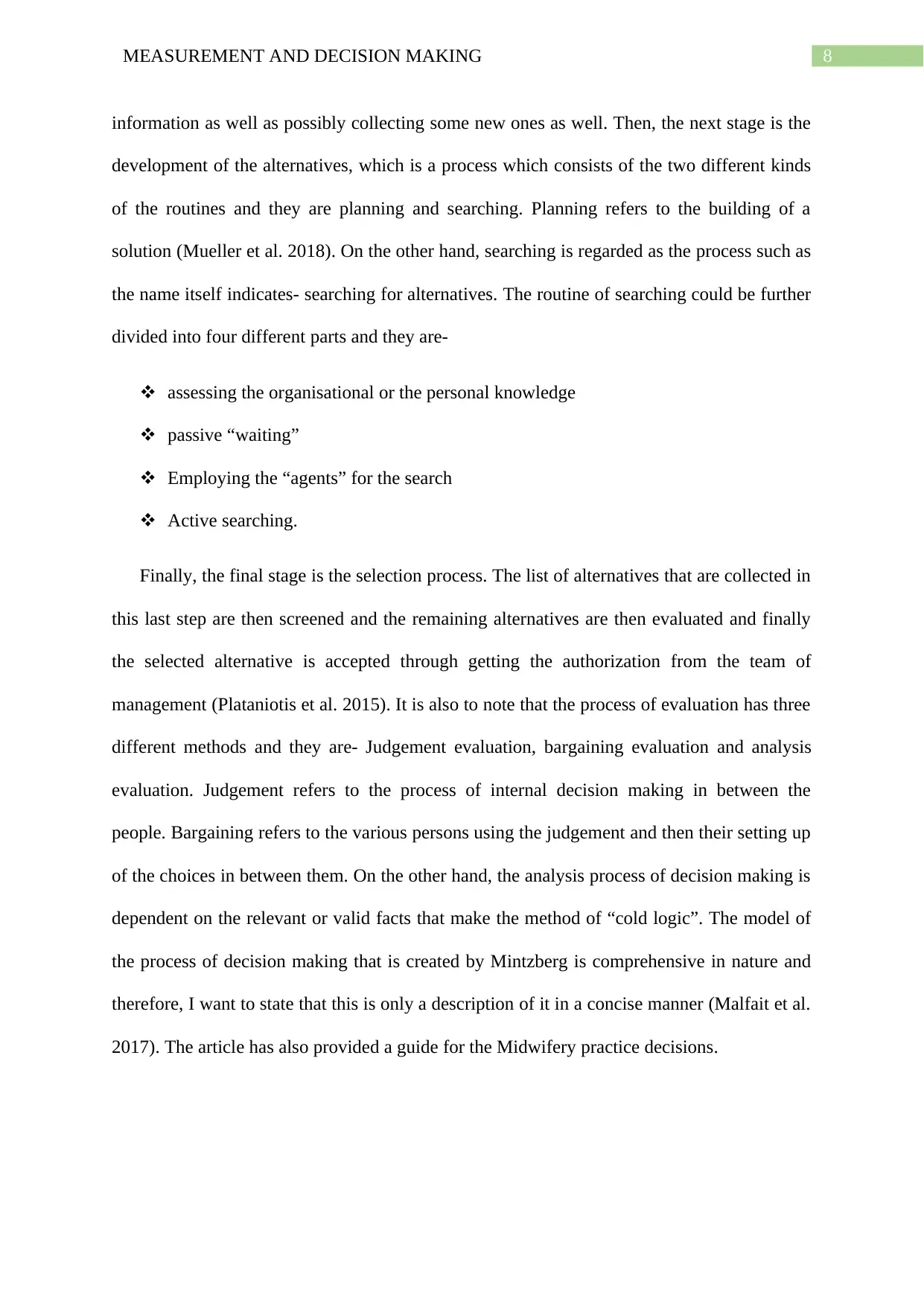
8MEASUREMENT AND DECISION MAKING
information as well as possibly collecting some new ones as well. Then, the next stage is the
development of the alternatives, which is a process which consists of the two different kinds
of the routines and they are planning and searching. Planning refers to the building of a
solution (Mueller et al. 2018). On the other hand, searching is regarded as the process such as
the name itself indicates- searching for alternatives. The routine of searching could be further
divided into four different parts and they are-
assessing the organisational or the personal knowledge
passive “waiting”
Employing the “agents” for the search
Active searching.
Finally, the final stage is the selection process. The list of alternatives that are collected in
this last step are then screened and the remaining alternatives are then evaluated and finally
the selected alternative is accepted through getting the authorization from the team of
management (Plataniotis et al. 2015). It is also to note that the process of evaluation has three
different methods and they are- Judgement evaluation, bargaining evaluation and analysis
evaluation. Judgement refers to the process of internal decision making in between the
people. Bargaining refers to the various persons using the judgement and then their setting up
of the choices in between them. On the other hand, the analysis process of decision making is
dependent on the relevant or valid facts that make the method of “cold logic”. The model of
the process of decision making that is created by Mintzberg is comprehensive in nature and
therefore, I want to state that this is only a description of it in a concise manner (Malfait et al.
2017). The article has also provided a guide for the Midwifery practice decisions.
information as well as possibly collecting some new ones as well. Then, the next stage is the
development of the alternatives, which is a process which consists of the two different kinds
of the routines and they are planning and searching. Planning refers to the building of a
solution (Mueller et al. 2018). On the other hand, searching is regarded as the process such as
the name itself indicates- searching for alternatives. The routine of searching could be further
divided into four different parts and they are-
assessing the organisational or the personal knowledge
passive “waiting”
Employing the “agents” for the search
Active searching.
Finally, the final stage is the selection process. The list of alternatives that are collected in
this last step are then screened and the remaining alternatives are then evaluated and finally
the selected alternative is accepted through getting the authorization from the team of
management (Plataniotis et al. 2015). It is also to note that the process of evaluation has three
different methods and they are- Judgement evaluation, bargaining evaluation and analysis
evaluation. Judgement refers to the process of internal decision making in between the
people. Bargaining refers to the various persons using the judgement and then their setting up
of the choices in between them. On the other hand, the analysis process of decision making is
dependent on the relevant or valid facts that make the method of “cold logic”. The model of
the process of decision making that is created by Mintzberg is comprehensive in nature and
therefore, I want to state that this is only a description of it in a concise manner (Malfait et al.
2017). The article has also provided a guide for the Midwifery practice decisions.
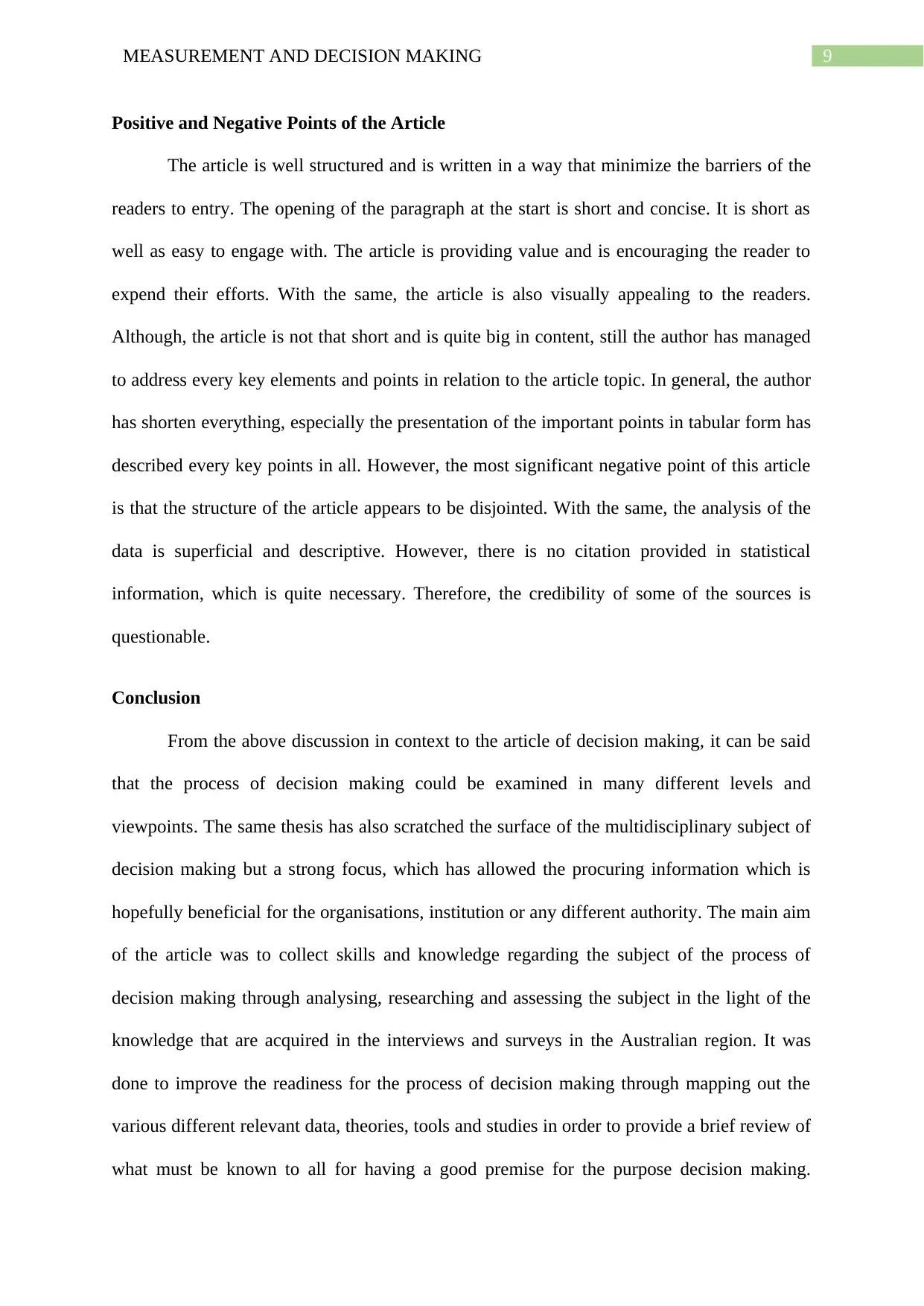
9MEASUREMENT AND DECISION MAKING
Positive and Negative Points of the Article
The article is well structured and is written in a way that minimize the barriers of the
readers to entry. The opening of the paragraph at the start is short and concise. It is short as
well as easy to engage with. The article is providing value and is encouraging the reader to
expend their efforts. With the same, the article is also visually appealing to the readers.
Although, the article is not that short and is quite big in content, still the author has managed
to address every key elements and points in relation to the article topic. In general, the author
has shorten everything, especially the presentation of the important points in tabular form has
described every key points in all. However, the most significant negative point of this article
is that the structure of the article appears to be disjointed. With the same, the analysis of the
data is superficial and descriptive. However, there is no citation provided in statistical
information, which is quite necessary. Therefore, the credibility of some of the sources is
questionable.
Conclusion
From the above discussion in context to the article of decision making, it can be said
that the process of decision making could be examined in many different levels and
viewpoints. The same thesis has also scratched the surface of the multidisciplinary subject of
decision making but a strong focus, which has allowed the procuring information which is
hopefully beneficial for the organisations, institution or any different authority. The main aim
of the article was to collect skills and knowledge regarding the subject of the process of
decision making through analysing, researching and assessing the subject in the light of the
knowledge that are acquired in the interviews and surveys in the Australian region. It was
done to improve the readiness for the process of decision making through mapping out the
various different relevant data, theories, tools and studies in order to provide a brief review of
what must be known to all for having a good premise for the purpose decision making.
Positive and Negative Points of the Article
The article is well structured and is written in a way that minimize the barriers of the
readers to entry. The opening of the paragraph at the start is short and concise. It is short as
well as easy to engage with. The article is providing value and is encouraging the reader to
expend their efforts. With the same, the article is also visually appealing to the readers.
Although, the article is not that short and is quite big in content, still the author has managed
to address every key elements and points in relation to the article topic. In general, the author
has shorten everything, especially the presentation of the important points in tabular form has
described every key points in all. However, the most significant negative point of this article
is that the structure of the article appears to be disjointed. With the same, the analysis of the
data is superficial and descriptive. However, there is no citation provided in statistical
information, which is quite necessary. Therefore, the credibility of some of the sources is
questionable.
Conclusion
From the above discussion in context to the article of decision making, it can be said
that the process of decision making could be examined in many different levels and
viewpoints. The same thesis has also scratched the surface of the multidisciplinary subject of
decision making but a strong focus, which has allowed the procuring information which is
hopefully beneficial for the organisations, institution or any different authority. The main aim
of the article was to collect skills and knowledge regarding the subject of the process of
decision making through analysing, researching and assessing the subject in the light of the
knowledge that are acquired in the interviews and surveys in the Australian region. It was
done to improve the readiness for the process of decision making through mapping out the
various different relevant data, theories, tools and studies in order to provide a brief review of
what must be known to all for having a good premise for the purpose decision making.
Secure Best Marks with AI Grader
Need help grading? Try our AI Grader for instant feedback on your assignments.
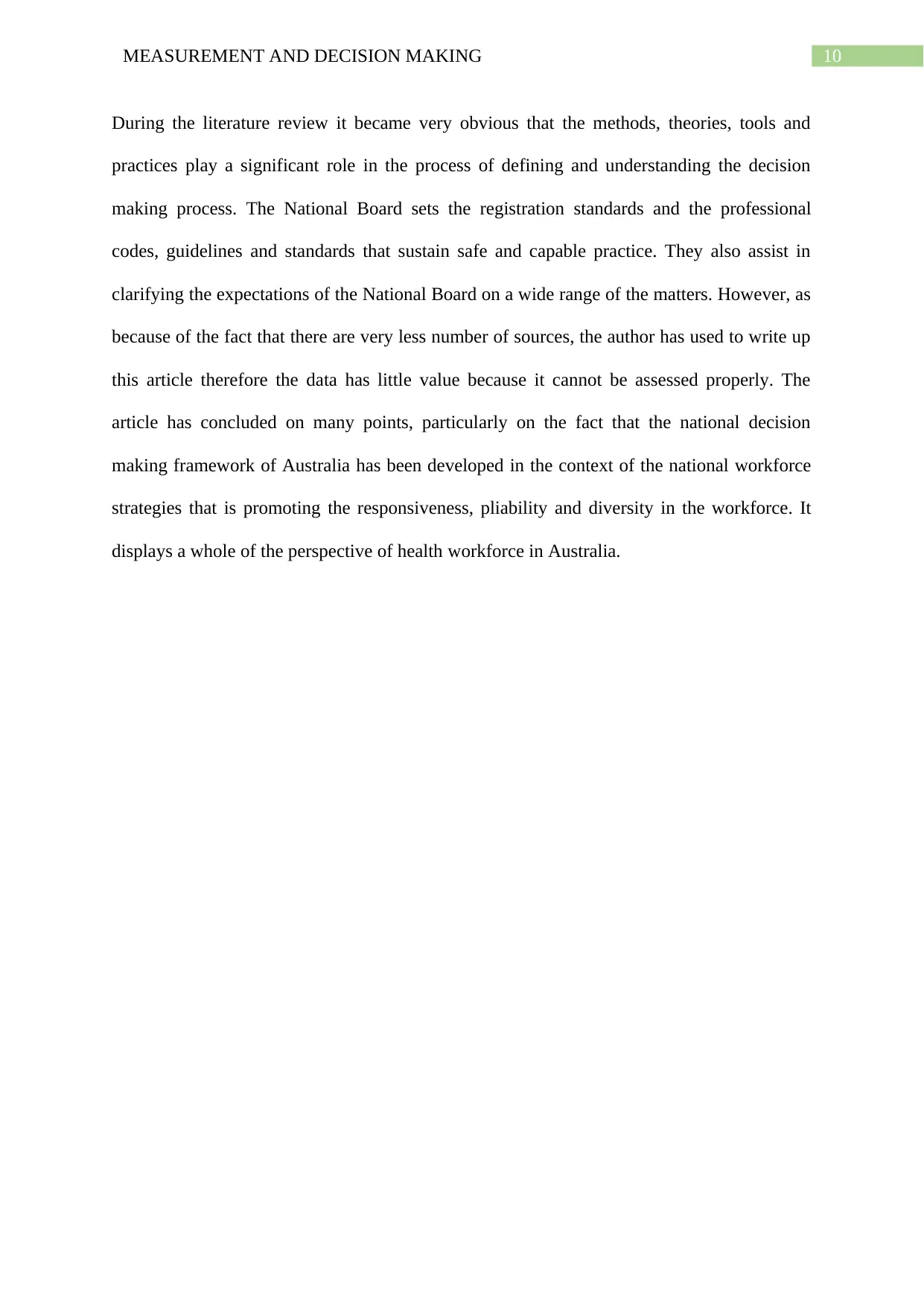
10MEASUREMENT AND DECISION MAKING
During the literature review it became very obvious that the methods, theories, tools and
practices play a significant role in the process of defining and understanding the decision
making process. The National Board sets the registration standards and the professional
codes, guidelines and standards that sustain safe and capable practice. They also assist in
clarifying the expectations of the National Board on a wide range of the matters. However, as
because of the fact that there are very less number of sources, the author has used to write up
this article therefore the data has little value because it cannot be assessed properly. The
article has concluded on many points, particularly on the fact that the national decision
making framework of Australia has been developed in the context of the national workforce
strategies that is promoting the responsiveness, pliability and diversity in the workforce. It
displays a whole of the perspective of health workforce in Australia.
During the literature review it became very obvious that the methods, theories, tools and
practices play a significant role in the process of defining and understanding the decision
making process. The National Board sets the registration standards and the professional
codes, guidelines and standards that sustain safe and capable practice. They also assist in
clarifying the expectations of the National Board on a wide range of the matters. However, as
because of the fact that there are very less number of sources, the author has used to write up
this article therefore the data has little value because it cannot be assessed properly. The
article has concluded on many points, particularly on the fact that the national decision
making framework of Australia has been developed in the context of the national workforce
strategies that is promoting the responsiveness, pliability and diversity in the workforce. It
displays a whole of the perspective of health workforce in Australia.
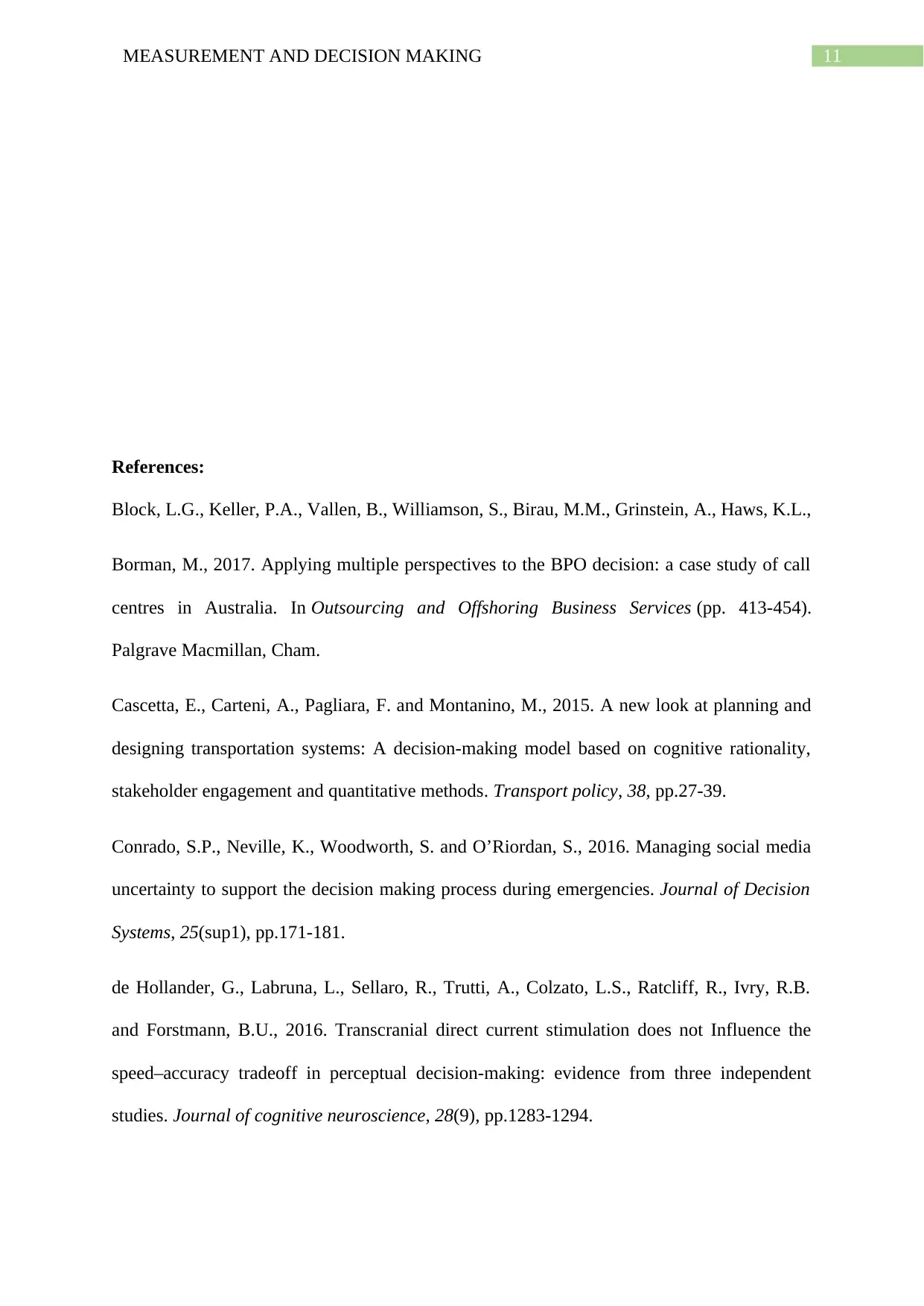
11MEASUREMENT AND DECISION MAKING
References:
Block, L.G., Keller, P.A., Vallen, B., Williamson, S., Birau, M.M., Grinstein, A., Haws, K.L.,
Borman, M., 2017. Applying multiple perspectives to the BPO decision: a case study of call
centres in Australia. In Outsourcing and Offshoring Business Services (pp. 413-454).
Palgrave Macmillan, Cham.
Cascetta, E., Carteni, A., Pagliara, F. and Montanino, M., 2015. A new look at planning and
designing transportation systems: A decision-making model based on cognitive rationality,
stakeholder engagement and quantitative methods. Transport policy, 38, pp.27-39.
Conrado, S.P., Neville, K., Woodworth, S. and O’Riordan, S., 2016. Managing social media
uncertainty to support the decision making process during emergencies. Journal of Decision
Systems, 25(sup1), pp.171-181.
de Hollander, G., Labruna, L., Sellaro, R., Trutti, A., Colzato, L.S., Ratcliff, R., Ivry, R.B.
and Forstmann, B.U., 2016. Transcranial direct current stimulation does not Influence the
speed–accuracy tradeoff in perceptual decision-making: evidence from three independent
studies. Journal of cognitive neuroscience, 28(9), pp.1283-1294.
References:
Block, L.G., Keller, P.A., Vallen, B., Williamson, S., Birau, M.M., Grinstein, A., Haws, K.L.,
Borman, M., 2017. Applying multiple perspectives to the BPO decision: a case study of call
centres in Australia. In Outsourcing and Offshoring Business Services (pp. 413-454).
Palgrave Macmillan, Cham.
Cascetta, E., Carteni, A., Pagliara, F. and Montanino, M., 2015. A new look at planning and
designing transportation systems: A decision-making model based on cognitive rationality,
stakeholder engagement and quantitative methods. Transport policy, 38, pp.27-39.
Conrado, S.P., Neville, K., Woodworth, S. and O’Riordan, S., 2016. Managing social media
uncertainty to support the decision making process during emergencies. Journal of Decision
Systems, 25(sup1), pp.171-181.
de Hollander, G., Labruna, L., Sellaro, R., Trutti, A., Colzato, L.S., Ratcliff, R., Ivry, R.B.
and Forstmann, B.U., 2016. Transcranial direct current stimulation does not Influence the
speed–accuracy tradeoff in perceptual decision-making: evidence from three independent
studies. Journal of cognitive neuroscience, 28(9), pp.1283-1294.
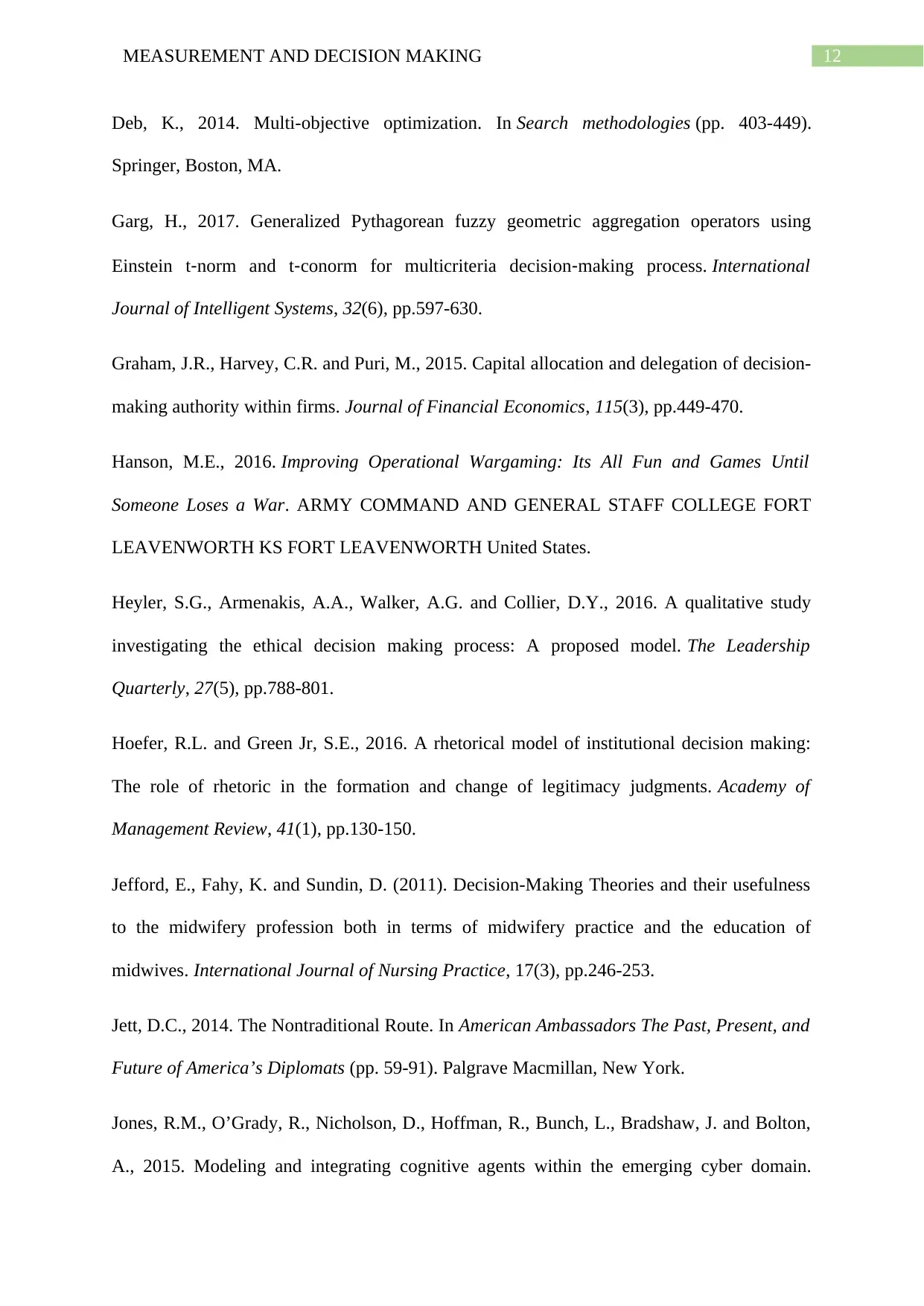
12MEASUREMENT AND DECISION MAKING
Deb, K., 2014. Multi-objective optimization. In Search methodologies (pp. 403-449).
Springer, Boston, MA.
Garg, H., 2017. Generalized Pythagorean fuzzy geometric aggregation operators using
Einstein t‐norm and t‐conorm for multicriteria decision‐making process. International
Journal of Intelligent Systems, 32(6), pp.597-630.
Graham, J.R., Harvey, C.R. and Puri, M., 2015. Capital allocation and delegation of decision-
making authority within firms. Journal of Financial Economics, 115(3), pp.449-470.
Hanson, M.E., 2016. Improving Operational Wargaming: Its All Fun and Games Until
Someone Loses a War. ARMY COMMAND AND GENERAL STAFF COLLEGE FORT
LEAVENWORTH KS FORT LEAVENWORTH United States.
Heyler, S.G., Armenakis, A.A., Walker, A.G. and Collier, D.Y., 2016. A qualitative study
investigating the ethical decision making process: A proposed model. The Leadership
Quarterly, 27(5), pp.788-801.
Hoefer, R.L. and Green Jr, S.E., 2016. A rhetorical model of institutional decision making:
The role of rhetoric in the formation and change of legitimacy judgments. Academy of
Management Review, 41(1), pp.130-150.
Jefford, E., Fahy, K. and Sundin, D. (2011). Decision-Making Theories and their usefulness
to the midwifery profession both in terms of midwifery practice and the education of
midwives. International Journal of Nursing Practice, 17(3), pp.246-253.
Jett, D.C., 2014. The Nontraditional Route. In American Ambassadors The Past, Present, and
Future of America’s Diplomats (pp. 59-91). Palgrave Macmillan, New York.
Jones, R.M., O’Grady, R., Nicholson, D., Hoffman, R., Bunch, L., Bradshaw, J. and Bolton,
A., 2015. Modeling and integrating cognitive agents within the emerging cyber domain.
Deb, K., 2014. Multi-objective optimization. In Search methodologies (pp. 403-449).
Springer, Boston, MA.
Garg, H., 2017. Generalized Pythagorean fuzzy geometric aggregation operators using
Einstein t‐norm and t‐conorm for multicriteria decision‐making process. International
Journal of Intelligent Systems, 32(6), pp.597-630.
Graham, J.R., Harvey, C.R. and Puri, M., 2015. Capital allocation and delegation of decision-
making authority within firms. Journal of Financial Economics, 115(3), pp.449-470.
Hanson, M.E., 2016. Improving Operational Wargaming: Its All Fun and Games Until
Someone Loses a War. ARMY COMMAND AND GENERAL STAFF COLLEGE FORT
LEAVENWORTH KS FORT LEAVENWORTH United States.
Heyler, S.G., Armenakis, A.A., Walker, A.G. and Collier, D.Y., 2016. A qualitative study
investigating the ethical decision making process: A proposed model. The Leadership
Quarterly, 27(5), pp.788-801.
Hoefer, R.L. and Green Jr, S.E., 2016. A rhetorical model of institutional decision making:
The role of rhetoric in the formation and change of legitimacy judgments. Academy of
Management Review, 41(1), pp.130-150.
Jefford, E., Fahy, K. and Sundin, D. (2011). Decision-Making Theories and their usefulness
to the midwifery profession both in terms of midwifery practice and the education of
midwives. International Journal of Nursing Practice, 17(3), pp.246-253.
Jett, D.C., 2014. The Nontraditional Route. In American Ambassadors The Past, Present, and
Future of America’s Diplomats (pp. 59-91). Palgrave Macmillan, New York.
Jones, R.M., O’Grady, R., Nicholson, D., Hoffman, R., Bunch, L., Bradshaw, J. and Bolton,
A., 2015. Modeling and integrating cognitive agents within the emerging cyber domain.
Paraphrase This Document
Need a fresh take? Get an instant paraphrase of this document with our AI Paraphraser
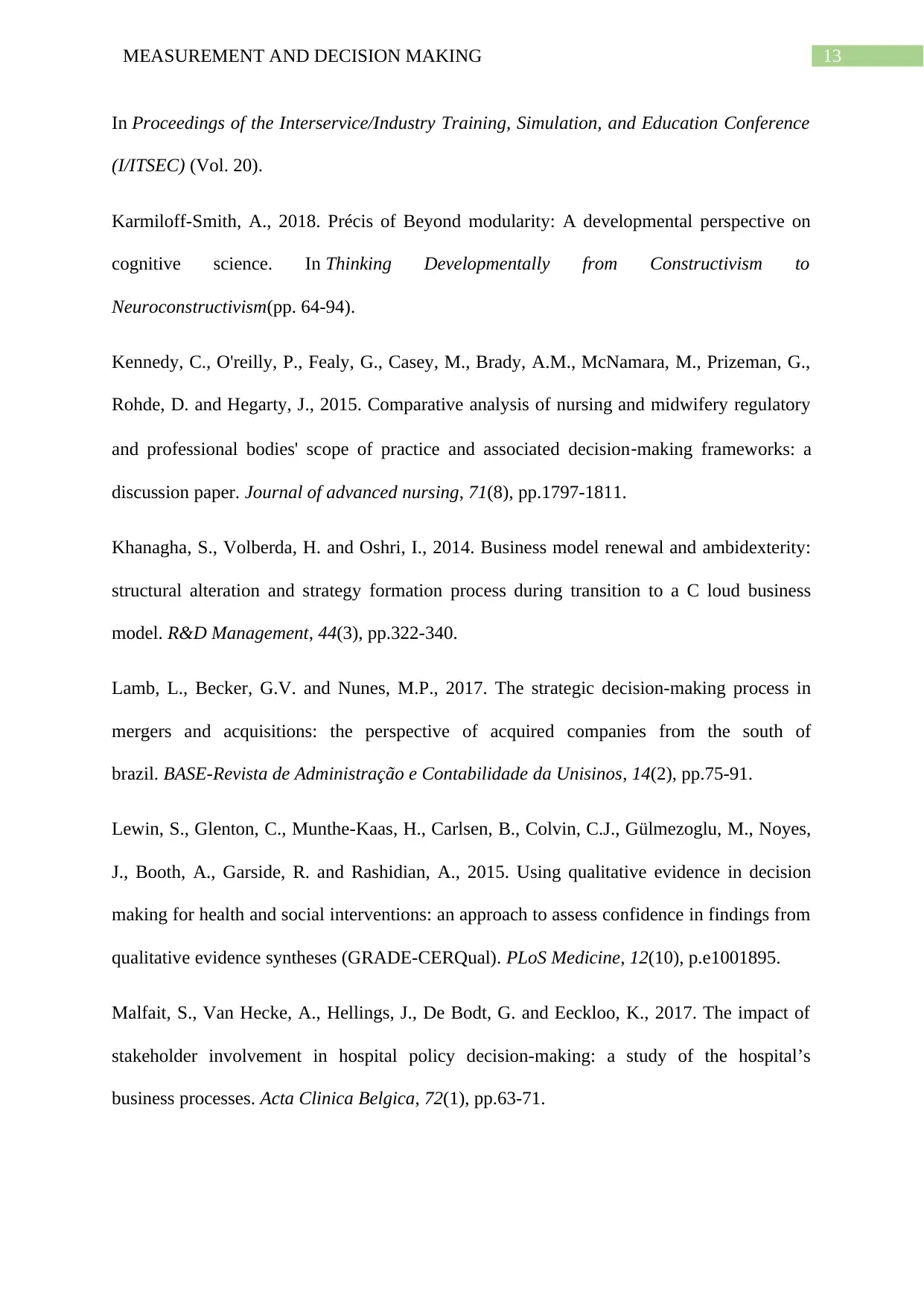
13MEASUREMENT AND DECISION MAKING
In Proceedings of the Interservice/Industry Training, Simulation, and Education Conference
(I/ITSEC) (Vol. 20).
Karmiloff-Smith, A., 2018. Précis of Beyond modularity: A developmental perspective on
cognitive science. In Thinking Developmentally from Constructivism to
Neuroconstructivism(pp. 64-94).
Kennedy, C., O'reilly, P., Fealy, G., Casey, M., Brady, A.M., McNamara, M., Prizeman, G.,
Rohde, D. and Hegarty, J., 2015. Comparative analysis of nursing and midwifery regulatory
and professional bodies' scope of practice and associated decision‐making frameworks: a
discussion paper. Journal of advanced nursing, 71(8), pp.1797-1811.
Khanagha, S., Volberda, H. and Oshri, I., 2014. Business model renewal and ambidexterity:
structural alteration and strategy formation process during transition to a C loud business
model. R&D Management, 44(3), pp.322-340.
Lamb, L., Becker, G.V. and Nunes, M.P., 2017. The strategic decision-making process in
mergers and acquisitions: the perspective of acquired companies from the south of
brazil. BASE-Revista de Administração e Contabilidade da Unisinos, 14(2), pp.75-91.
Lewin, S., Glenton, C., Munthe-Kaas, H., Carlsen, B., Colvin, C.J., Gülmezoglu, M., Noyes,
J., Booth, A., Garside, R. and Rashidian, A., 2015. Using qualitative evidence in decision
making for health and social interventions: an approach to assess confidence in findings from
qualitative evidence syntheses (GRADE-CERQual). PLoS Medicine, 12(10), p.e1001895.
Malfait, S., Van Hecke, A., Hellings, J., De Bodt, G. and Eeckloo, K., 2017. The impact of
stakeholder involvement in hospital policy decision-making: a study of the hospital’s
business processes. Acta Clinica Belgica, 72(1), pp.63-71.
In Proceedings of the Interservice/Industry Training, Simulation, and Education Conference
(I/ITSEC) (Vol. 20).
Karmiloff-Smith, A., 2018. Précis of Beyond modularity: A developmental perspective on
cognitive science. In Thinking Developmentally from Constructivism to
Neuroconstructivism(pp. 64-94).
Kennedy, C., O'reilly, P., Fealy, G., Casey, M., Brady, A.M., McNamara, M., Prizeman, G.,
Rohde, D. and Hegarty, J., 2015. Comparative analysis of nursing and midwifery regulatory
and professional bodies' scope of practice and associated decision‐making frameworks: a
discussion paper. Journal of advanced nursing, 71(8), pp.1797-1811.
Khanagha, S., Volberda, H. and Oshri, I., 2014. Business model renewal and ambidexterity:
structural alteration and strategy formation process during transition to a C loud business
model. R&D Management, 44(3), pp.322-340.
Lamb, L., Becker, G.V. and Nunes, M.P., 2017. The strategic decision-making process in
mergers and acquisitions: the perspective of acquired companies from the south of
brazil. BASE-Revista de Administração e Contabilidade da Unisinos, 14(2), pp.75-91.
Lewin, S., Glenton, C., Munthe-Kaas, H., Carlsen, B., Colvin, C.J., Gülmezoglu, M., Noyes,
J., Booth, A., Garside, R. and Rashidian, A., 2015. Using qualitative evidence in decision
making for health and social interventions: an approach to assess confidence in findings from
qualitative evidence syntheses (GRADE-CERQual). PLoS Medicine, 12(10), p.e1001895.
Malfait, S., Van Hecke, A., Hellings, J., De Bodt, G. and Eeckloo, K., 2017. The impact of
stakeholder involvement in hospital policy decision-making: a study of the hospital’s
business processes. Acta Clinica Belgica, 72(1), pp.63-71.
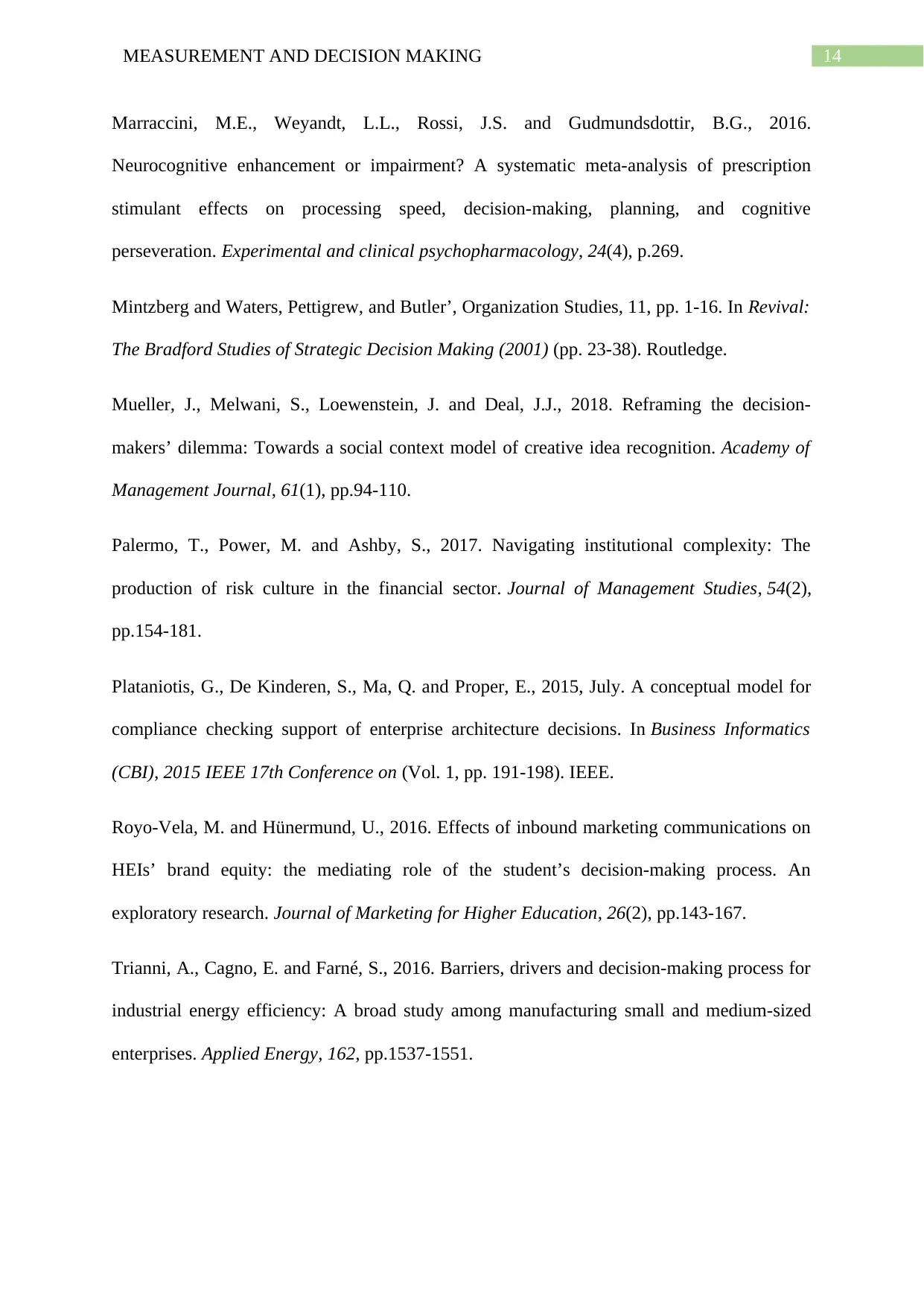
14MEASUREMENT AND DECISION MAKING
Marraccini, M.E., Weyandt, L.L., Rossi, J.S. and Gudmundsdottir, B.G., 2016.
Neurocognitive enhancement or impairment? A systematic meta-analysis of prescription
stimulant effects on processing speed, decision-making, planning, and cognitive
perseveration. Experimental and clinical psychopharmacology, 24(4), p.269.
Mintzberg and Waters, Pettigrew, and Butler’, Organization Studies, 11, pp. 1-16. In Revival:
The Bradford Studies of Strategic Decision Making (2001) (pp. 23-38). Routledge.
Mueller, J., Melwani, S., Loewenstein, J. and Deal, J.J., 2018. Reframing the decision-
makers’ dilemma: Towards a social context model of creative idea recognition. Academy of
Management Journal, 61(1), pp.94-110.
Palermo, T., Power, M. and Ashby, S., 2017. Navigating institutional complexity: The
production of risk culture in the financial sector. Journal of Management Studies, 54(2),
pp.154-181.
Plataniotis, G., De Kinderen, S., Ma, Q. and Proper, E., 2015, July. A conceptual model for
compliance checking support of enterprise architecture decisions. In Business Informatics
(CBI), 2015 IEEE 17th Conference on (Vol. 1, pp. 191-198). IEEE.
Royo-Vela, M. and Hünermund, U., 2016. Effects of inbound marketing communications on
HEIs’ brand equity: the mediating role of the student’s decision-making process. An
exploratory research. Journal of Marketing for Higher Education, 26(2), pp.143-167.
Trianni, A., Cagno, E. and Farné, S., 2016. Barriers, drivers and decision-making process for
industrial energy efficiency: A broad study among manufacturing small and medium-sized
enterprises. Applied Energy, 162, pp.1537-1551.
Marraccini, M.E., Weyandt, L.L., Rossi, J.S. and Gudmundsdottir, B.G., 2016.
Neurocognitive enhancement or impairment? A systematic meta-analysis of prescription
stimulant effects on processing speed, decision-making, planning, and cognitive
perseveration. Experimental and clinical psychopharmacology, 24(4), p.269.
Mintzberg and Waters, Pettigrew, and Butler’, Organization Studies, 11, pp. 1-16. In Revival:
The Bradford Studies of Strategic Decision Making (2001) (pp. 23-38). Routledge.
Mueller, J., Melwani, S., Loewenstein, J. and Deal, J.J., 2018. Reframing the decision-
makers’ dilemma: Towards a social context model of creative idea recognition. Academy of
Management Journal, 61(1), pp.94-110.
Palermo, T., Power, M. and Ashby, S., 2017. Navigating institutional complexity: The
production of risk culture in the financial sector. Journal of Management Studies, 54(2),
pp.154-181.
Plataniotis, G., De Kinderen, S., Ma, Q. and Proper, E., 2015, July. A conceptual model for
compliance checking support of enterprise architecture decisions. In Business Informatics
(CBI), 2015 IEEE 17th Conference on (Vol. 1, pp. 191-198). IEEE.
Royo-Vela, M. and Hünermund, U., 2016. Effects of inbound marketing communications on
HEIs’ brand equity: the mediating role of the student’s decision-making process. An
exploratory research. Journal of Marketing for Higher Education, 26(2), pp.143-167.
Trianni, A., Cagno, E. and Farné, S., 2016. Barriers, drivers and decision-making process for
industrial energy efficiency: A broad study among manufacturing small and medium-sized
enterprises. Applied Energy, 162, pp.1537-1551.
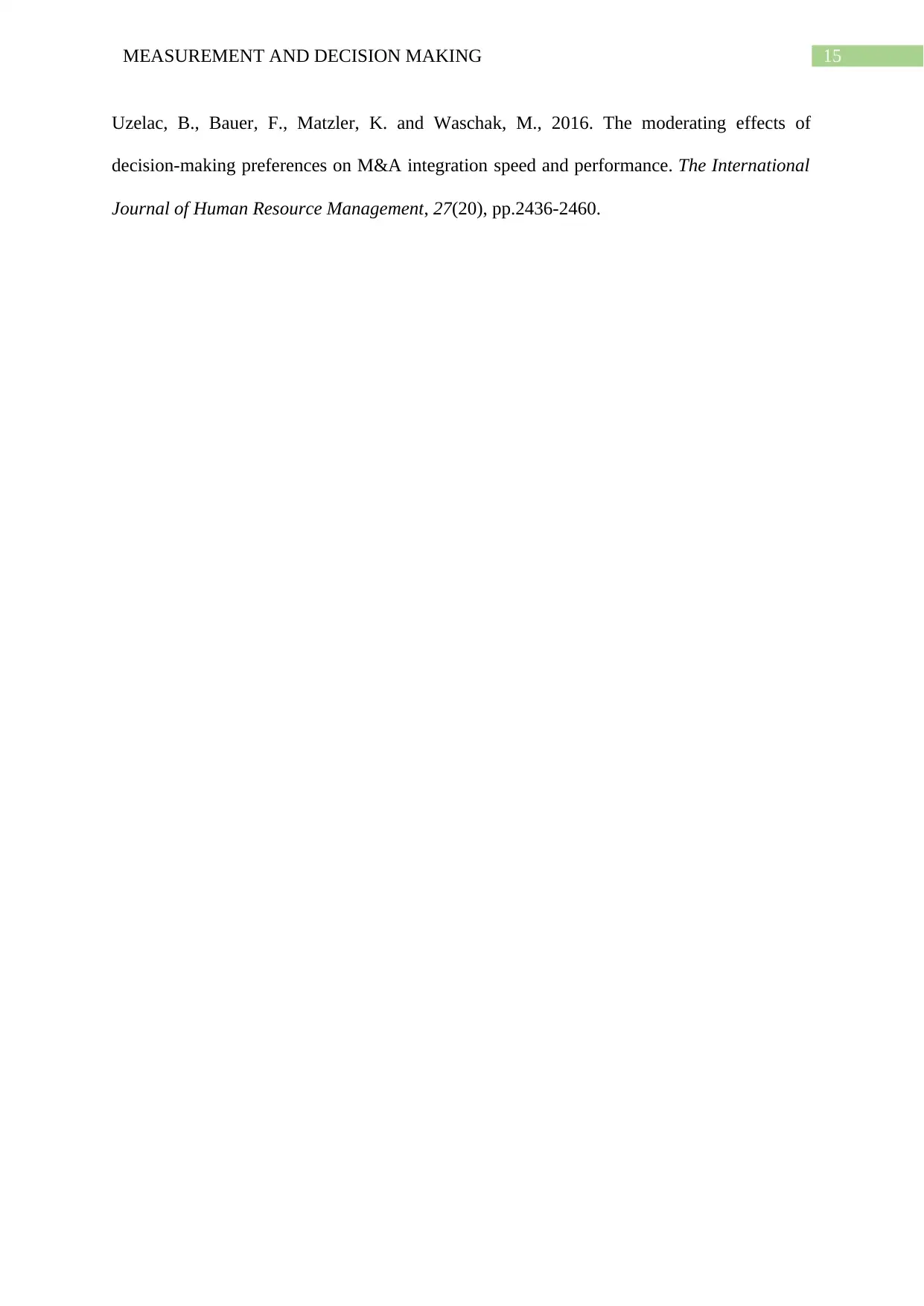
15MEASUREMENT AND DECISION MAKING
Uzelac, B., Bauer, F., Matzler, K. and Waschak, M., 2016. The moderating effects of
decision-making preferences on M&A integration speed and performance. The International
Journal of Human Resource Management, 27(20), pp.2436-2460.
Uzelac, B., Bauer, F., Matzler, K. and Waschak, M., 2016. The moderating effects of
decision-making preferences on M&A integration speed and performance. The International
Journal of Human Resource Management, 27(20), pp.2436-2460.
1 out of 16
Related Documents
Your All-in-One AI-Powered Toolkit for Academic Success.
+13062052269
info@desklib.com
Available 24*7 on WhatsApp / Email
![[object Object]](/_next/static/media/star-bottom.7253800d.svg)
Unlock your academic potential
© 2024 | Zucol Services PVT LTD | All rights reserved.





